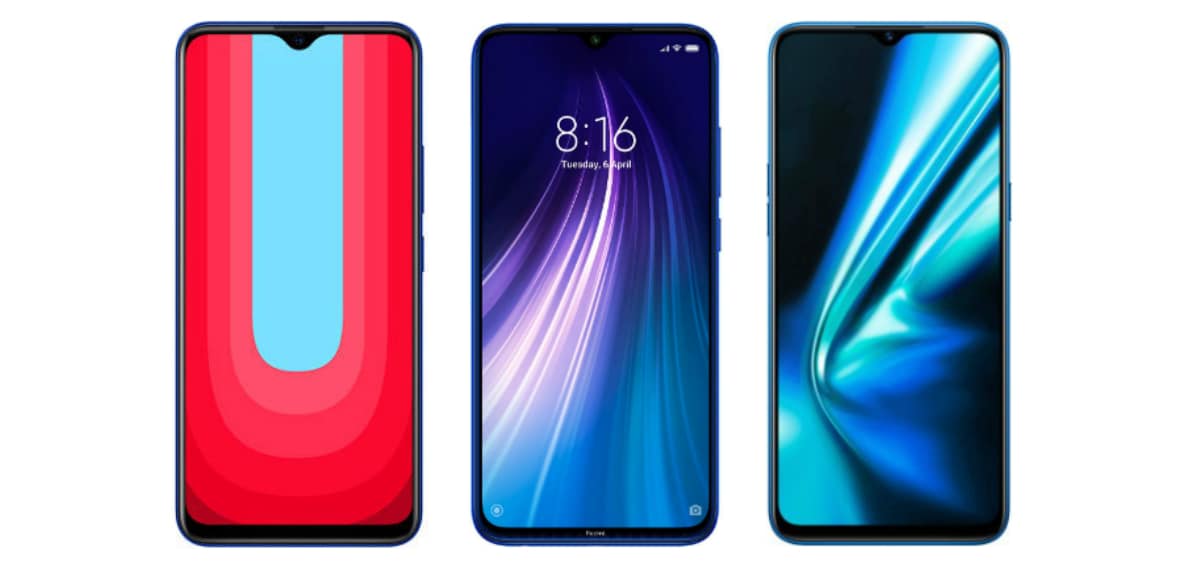Xiaomi on Monday launched the new Redmi Note 7S in India, expanding its smartphone portfolio. With this new addition, there are now three phones in the Redmi Note 7 series – the vanilla Redmi Note 7, the Redmi Note 7 Pro, and the Redmi Note 7S. The three phones have few differences setting them apart, catering to different customers across different price tags. On the board, the Redmi Note 7S seems to be similar to the Redmi Note 7 China variant that was launched in January this year. The phone features a 48-megapixel primary shooter, up to 4GB of RAM, and 4,000mAh battery.
We pit the Redmi Note 7S against the Redmi Note 7 and the Redmi Note 7 Pro to highlight all the differences between the three phones.
Redmi Note 7 vs Redmi Note 7S vs Redmi Note 7 Pro price in India
The Redmi Note 7S price in India has been set at Rs. 10,999 for the 3GB RAM + 32GB storage mode, whereas the 4GB RAM + 64GB storage variant of the smartphone is priced at Rs. 12,999. Both variants come in three distinct colour options, namely Onyx Black, Ruby Red, and Sapphire Blue. Xiaomi will start selling the Redmi Note 7S in India through Flipkart, Mi.com, and Mi Home stores from May 23, Thursday.
The Redmi Note 7 Pro is the most premium of the lot, and its price in India is set at Rs. 13,999 for the 4GB RAM + 64GB storage option, while its 6GB RAM + 128GB storage variant is priced at Rs. 16,999. The phone comes in Neptune Blue, Nebula Red, and Space Black colour options. It is also sold via Flipkart, Mi.com, and Mi Home Stores.
Lastly, the Redmi Note 7 is priced in India starting at Rs. 9,999 for the 3GB + 32GB variant, while its 6GB + 64GB model is priced at Rs. 11,999. The Redmi Note 7 has Onyx Black, Ruby Red, and Sapphire Blue colour variants. It is also sold via Flipkart, Mi.com, and Mi Home stores.![]()
Like Redmi Note 7S, Redmi Note 7 Pro houses a 48-megapixel primary camera
Redmi Note 7 vs Redmi Note 7S vs Redmi Note 7 Pro specifications
All three phones run on Android Pie-based MIUI 10, feature dual-SIM slots, and sport 3.5mm audio jack slots. The phones also pack a 6.3-inch Full-HD+ (1080×2340 pixels) screen with 19.5:9 aspect ratio, waterdrop-style notch, and 409ppi pixel density. The Redmi Note 7 Pro is powered by the Qualcomm Snapdragon 675 SoC, coupled with 4GB/ 6GB of RAM, and 64GB/ 128GB of inbuilt storage with a microSD card slot (up to 256GB).
The Redmi Note 7S, on the other hand, has an octa-core Qualcomm Snapdragon 660 SoC that is clocked at 2.2GHz, coupled with up to 4GB of RAM. In terms of storage, the Redmi Note 7S has 32GB and 64GB of onboard storage options, both of which are expandable via microSD card (up to 256GB).
The Redmi Note 7, lastly, is powered by Qualcomm’s Snapdragon 660 octa-core SoC and packs 3GB/ 4GB of RAM. It also includes 32GB/ 64GB of inbuilt storage and a microSD card slot (up to 256GB) for further expansion.
For photos and videos, the Redmi Note 7S comes with dual rear camera setup that includes a 48-megapixel primary sensor with an f/1.8 lens. There is also a 5-megapixel secondary sensor. Xiaomi has also provided a 13-megapixel sensor at the front that supports AI Portrait mode and AI Face unlock.
The Redmi Note 7 Pro also packs a dual camera setup on the back that includes a 48-megapixel primary sensor and a 5-megapixel secondary depth sensor. Additionally, there is the same 13-megapixel front shooter on the phone.
Lastly, the Redmi Note 7 features a dual camera setup on the back that houses a primary 12-megapixel sensor with a secondary 2-megapixel depth sensor. There is a 13-megapixel front shooter on-board here as well.
All Redmi Note 7 series phones pack 4,000mAh battery with fast charging support. Their dimensions are identical at 159.21×75.21×8.10mm, and they all weigh the same at around 185 grams.
Connectivity options on the three phones include Bluetooth v5, 3.5mm audio jack, Wi-Fi 802.11 ac, and dual 4G VoLTE.
Do Redmi Note 7 Pro, Redmi Note 7, and Mi Soundbar redefine their price segments? We discussed this on Orbital, our weekly technology podcast, which you can subscribe to via Apple Podcasts or RSS, download the episode, or just hit the play button below.
Redmi Note 7S vs Redmi Note 7 Pro vs Redmi Note 7 comparison
|
|
|
|
|
| Ratings | |||
| Overall NDTV Rating | |||
| Design Rating | |||
| Display Rating | |||
| Software Rating | |||
| Performance Rating | |||
| Battery Life Rating | |||
| Camera Rating | |||
| Value for Money Rating | |||
| Key Specs | |||
| Display | 6.30-inch | 6.30-inch | 6.30-inch |
| Processor | Qualcomm Snapdragon 660 | Qualcomm Snapdragon 675 | Qualcomm Snapdragon 660 |
| Front Camera | 13-megapixel | 13-megapixel | 13-megapixel |
| Rear Camera | 48-megapixel + 5-megapixel | 48-megapixel + 5-megapixel | 12-megapixel + 2-megapixel |
| RAM | 3GB | 4GB | 4GB |
| Storage | 32GB | 64GB | 64GB |
| Battery Capacity | 4000mAh | 4000mAh | 4000mAh |
| OS | Android Pie | Android Pie | Android 9.0 |
| Resolution | 1080×2340 pixels | 1080×2340 pixels | 1080×2340 pixels |
| GENERAL | |||
| Brand | Xiaomi | Xiaomi | Xiaomi |
| Model | Redmi Note 7S | Redmi Note 7 Pro | Redmi Note 7 |
| Release date | May 20, 2019 | February 1, 2019 | January 1, 2019 |
| Launched in India | Yes | Yes | Yes |
| Body type | Glass | Glass | Glass |
| Dimensions (mm) | 159.21 x 75.21 x 8.10 | 159.21 x 75.21 x 8.10 | 159.21 x 75.21 x 8.10 |
| Weight (g) | 186.00 | 186.00 | 185.00 |
| Battery capacity (mAh) | 4000 | 4000 | 4000 |
| Removable battery | No | No | No |
| Fast charging | Quick Charge 4+ | Quick Charge 4+ | Quick Charge |
| Colours | Onyx Black, Ruby Red, Sapphire Blue | Classic Space Black, Nebula Red, Neptune Blue | Onyx Black, Ruby Red, Sapphire Blue |
| SAR value | 1.60 | – | 0.96 |
| Wireless charging | – | – | No |
| DISPLAY | |||
| Screen size (inches) | 6.30 | 6.30 | 6.30 |
| Resolution | 1080×2340 pixels | 1080×2340 pixels | 1080×2340 pixels |
| Protection type | Gorilla Glass | Gorilla Glass | Gorilla Glass |
| Aspect ratio | 19.5:9 | 19.5:9 | 19.5:9 |
| Pixels per inch (PPI) | 409 | 409 | 409 |
| HARDWARE | |||
| Processor | 2.2GHz octa-core (4×2.2GHz + 4×1.8GHz) | 2GHz octa-core | 2.2GHz |
| Processor make | Qualcomm Snapdragon 660 | Qualcomm Snapdragon 675 | Qualcomm Snapdragon 660 |
| RAM | 3GB | 4GB | 4GB |
| Internal storage | 32GB | 64GB | 64GB |
| Expandable storage | Yes | Yes | Yes |
| Expandable storage type | microSD | microSD | microSD |
| Expandable storage up to (GB) | 256 | – | 256 |
| Dedicated microSD slot | No | – | No |
| CAMERA | |||
| Rear camera | 48-megapixel (f/1.79, 1.6-micron) + 5-megapixel | 48-megapixel (f/1.79, 1.6-micron) + 5-megapixel | 12-megapixel (f/2.2, 1.25-micron) + 2-megapixel |
| Rear autofocus | Yes | Yes | Yes |
| Rear flash | LED | LED | LED |
| Front camera | 13-megapixel (f/2.0, 1.12-micron) | 13-megapixel | 13-megapixel (f/2.0, 1.12-micron) |
| Front flash | No | – | – |
| SOFTWARE | |||
| Operating system | Android Pie | Android Pie | Android 9.0 |
| Skin | MIUI 10 | MIUI 10 | MIUI 10 |
| CONNECTIVITY | |||
| Wi-Fi standards supported | 802.11 a/b/g/n/ac | 802.11 a/b/g/n/ac | 802.11 a/b/g/n/ac |
| Bluetooth | Yes, v 5.00 | Yes, v 5.00 | Yes, v 5.00 |
| USB OTG | Yes | Yes | Yes |
| USB Type-C | Yes | Yes | Yes |
| Number of SIMs | 2 | 2 | 2 |
| Active 4G on both SIM cards | Yes | Yes | Yes |
| SIM 1 | |||
| SIM Type | Nano-SIM | Nano-SIM | Nano-SIM |
| 4G/ LTE | Yes | Yes | Yes |
| SIM 2 | |||
| SIM Type | Nano-SIM | Nano-SIM | Nano-SIM |
| 4G/ LTE | Yes | Yes | Yes |
| SENSORS | |||
| Face unlock | Yes | Yes | Yes |
| Fingerprint sensor | Yes | Yes | Yes |
| Compass/ Magnetometer | Yes | Yes | – |
| Proximity sensor | Yes | Yes | Yes |
| Accelerometer | Yes | Yes | Yes |
| Ambient light sensor | Yes | Yes | Yes |
| Gyroscope | Yes | Yes | Yes |



